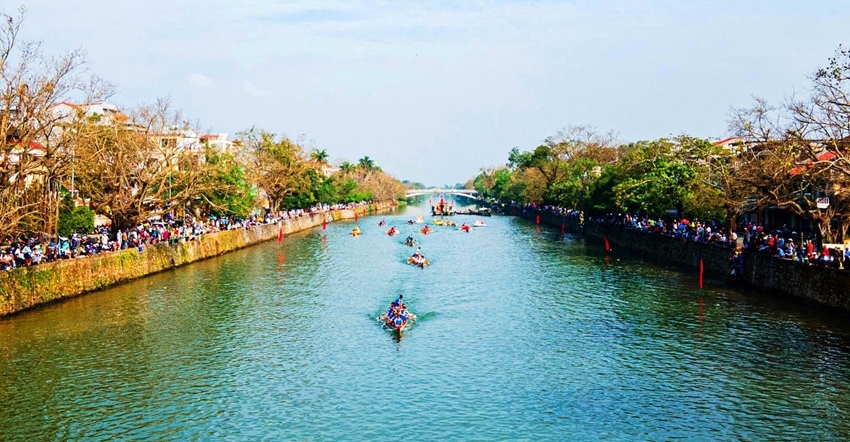In the past there was Hang Duong Street in Gia Hoi, running along the Dong Ba river from Gia Hoi Bridge to Dong Ba Bridge (Bach Dang Street). The street running from Gia Hoi Bridge to Dinh Market (Chi Lang Street) had originally been called Dinh Thi Pho, which was a busy business street in the east of Hue Citadel, founded by the Chinese in the mid-19th century.
 |
| A boat race on Dong Ba River |
In addition to villas and Phu de (princes’ and princesses’ residences in the past), Gia Hoi Old Quarter is filled with ancient garden houses, temples and pagodas. There are temples for the Chinese-Vietnamese such as Chieu Ung, Chua Ba, Quang Dong, Trieu Chau, Phuc Kien, and so on.
Among Vietnamese constructions are now national historical relics such as Thanh Binh Thu, which is dedicated to the ancestors of Vietnamese opera and those who contributed a lot to it in the Nguyen dynasty, Kim Hoan Ancestry House, the apricot blossom garden of the well-known traditional opera composer Dao Tan.
Gia Hoi Old Quarter now is well known not only for those old historical and cultural constructions but also for the kite-flying craft on Mac Dinh Chi Street, Dr. Nguyen Van Chuong’s private residence on Chi Lang Street, well known for his collection of ancient coins. There are also researchers’ book treasures such as Phan Thuan An’s at Princess Ngoc Son’s Temple, Vinh Cao’s on To Hien Thanh Street, and Ho Tan Phan’s on Cao Ba Quat Street.
In 2001, the Thua Thien Hue Culture and Information Department drew up a project, aiming at conserving and promoting the values of the Gia Hoi-Cho Dinh area. The old quarter was planned to be embellished and some cultural and culinary services would be introduced.
On that basis, sight-seeing tours would be designed, encouraging the local people to invest in tourism together with the authorities. Hue Festivals 2002 and 2004 did include sight-seeing tours to Gia Hoi Old Quarter. But no one knew why the old quarter again missed the opportunity to thrive.
The fact that the potential of Gia Hoi Old Quarter having not been “awakened” yet has been so far the concern of many culture researchers as well as the authorities in Hue. Many people want to revive the old quarter, bringing it back to the time when it thrived in the end of the 19th century and the beginning of the 20th century. Gia Hoi should be a “museum” about a prosperous ancient town with the ultimate goal of improving lives of inhabitants there.
That can be called a “Hue Dream.” For the dream to come true, the old quarter needs a big project with a complete “script” and a good “director.” Of course, first of all, there must be the assistance of talented urban planners and urban managers.
In order to be able to provide good services, houses in the old quarter must be designed properly for three-generation families. They must be places where people can live and offer their services or produce souvenirs such as traditional lanterns, paper flowers, or draw pictures, make shoes, facial powder, me xung (sesame candy), etc.
Besides, boat wharfs should be revived; playgrounds, parks, commons should be built; and modern houses should be embellished properly.
The next step is to organize cultural services and tourist services to breathe life into the old quarter and improve the lives of people there in accordance with the principle of conservation for development. Accordingly, folk festivals and the typical lifestyle in the old quarter should be restored; traditional handicrafts should be produced; stores and shops should be arranged properly to meet shopping requirements by tourists to Hue.
Tourist products and services must obey the principle “Of the people and by the people in the old quarter.” There should be policies encouraging people in the old town to maximize their internal force or to connect with other organizations to produce products and create services with the support from the authorities in introducing, promoting and advertising.
The infrastructure in Gia Hoi Old Quarter should be embellished and improved. The sidewalks on Bach Dang Street should be extended toward the river in the same way as the ironwood bridge on the Perfume river. Parking spaces should be built and traffic should be supervised, especially at rush hours. There should be transient areas between the old quarter with Trinh Cong Street and Trinh Cong Son Park too. Some playgrounds for the community should be built at Trinh Cong Son Park to prevent the old quarter from becoming too crowded.
There have been many articles by senior social and human scientists about Gia Hoi Old Quarter, but they are purely theoretical research in terms of its potential values. This article suggests solutions, aiming at turning Gia Hoi Old Quarter into a tourist product, and on that basis, taking steps to thrive the old quarter.
Story: Thanh Tung. Photo: Hoang Phuoc